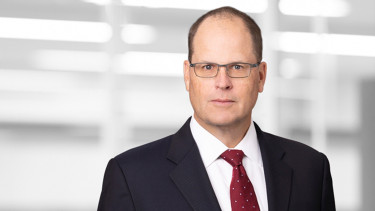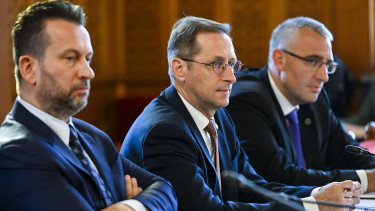Extreme financial risks and Budapest as a talent hub: Morgan Stanley's global leader talks to us

Portfolio: In recent times, numerous risk factors have emerged, ranging from geopolitical tensions and the transformative impact of artificial intelligence on labor markets and technology, to climate change. As the Chief Risk Officer of a global bank, which five threats do you consider most significant today for Morgan Stanley and its clients?
Charles Smith: There are a number of factors impacting markets that we are monitoring for our clients and across Morgan Stanley. One set of risks relates to the dynamic created by opposing market trends – think about economic growth vs. inflation, fiscal stimulus vs. fiscal discipline, or the expansion in private assets and the increasing participation of retail.
Tensions in these market forces can create tail risks.
Overlaying these market trends are broader geopolitical and policy risks, including the impact of tariffs and global conflicts. Finally, emerging technologies like AI, cryptocurrencies and stablecoins have strategic impacts to the industry that we need to manage.
Since the 2008 financial crisis, we have not witnessed a shock that fundamentally unsettled the banking sector. Do you see any developments in the money and capital markets that could carry such a risk? For example, could the growth of systemic risk transfers (SRTs), the rapid expansion of private lending, or the Chinese shadow banking system be considered part of this risk landscape?
What I watch is the growth in leverage.
Unlike 2008, neither corporates nor consumers are particularly leveraged.
Looking across the market for leverage, we watch the non-bank financial institutions. These market participants – hedge funds, private equity, private credit – are also our big clients. Compared with 2008 though, these are now larger and more sophisticated financial institutions with more developed risk management capabilities. Currently, we are seeing more leverage in the government sector around the world, particularly in developed countries, and that is definitely an area the markets and we are monitoring.
Over-regulation is often cited as a concern in both the United States and Europe. While the U.S. regulatory environment may see faster easing of bank-related burdens, Europe appears likely to adopt a slower, more gradual approach. How do you view the regulatory “race” between the two regions, and what risks are associated with the cyclical tightening and loosening of regulations?
The evolution of post-2008 banking regulation has produced significant benefits and the industry is better off for them. However, 17 years on it’s time to consider if we are at the right level – have the regulations over time accreted requirements that no longer add proportional value? In my view, looking at what is actually effective is healthy.
We should dial back unnecessary exams and buffers and focus on growth without compromising the long-term benefits of regulatory reform.
A re-examination is underway in the U.S. to determine whether the current regulatory burden is optimally balanced, to ensure commercial effectiveness without undermining the protective benefits established since 2008. Other jurisdictions are watching this closely. This is not a race to the bottom, but hopefully spurs regulators around the world to carefully re-evaluate what is actually effective oversight of safety and soundness and adjust appropriately. That is healthy.
Charles A. Smith
Executive Vice President and Chief Risk Officer at Morgan Stanley. He is also a member of the company's management and operating boards. He joined Morgan Stanley's investment banking division in 1996. After spending more than a decade in investment banking, he held a number of leadership positions at the firm, including head of business development for the Institutional Securities Group (ISG), chief financial officer of ISG, president of Morgan Stanley Bank, N.A., and head of strategy and execution for Morgan Stanley Private Bank, N.A., and head of strategy and execution for the firm. In these roles, he participated in a number of significant strategic events for the firm, including the acquisition of Smith Barney and the strategic partnership between MUFG and Morgan Stanley. Charles A. Smith holds a BBA from Southern Methodist University and an MBA from the Wharton School of the University of Pennsylvania. He serves on the board of directors of The Local Initiatives Support Corporation (LISC), one of the largest community development organizations in the United States.
How does Morgan Stanley strike the right balance between rigorous risk management and the pursuit of business growth? Is this a continuous strategic challenge, or more of a well-defined operational task driven by strict regulatory frameworks?
This is an interesting question because I don’t think of it as a balance between the two. It is a necessity to have effective risk management in order to enable business growth. In other words,
risk management is not an alternative to business growth – it is essential to drive sustainble business growth.
We need to maintain rigorous risk oversight at all times to avoid complacency, particularly during periods of market strength. Complacency can create tail risks and existential risk for the institution. I once heard a quote – the way to fail as a risk manager is to lack imagination – meaning that a good risk manager must be able to envision and avoid tail risks, even when they are unprecedented.
Why has Budapest emerged as one of Morgan Stanley’s key centers for global risk management? In what ways does the role of the Hungarian team differ from other regions, and are there areas in which it demonstrates particular expertise?
Budapest has emerged as a critical center due to its access to a well-educated talent pool and the breadth of capabilities we now have here, enabling comprehensive, end-to-end risk management processes.
In fact, a quarter of our risk professionals are now based in Budapest and they are involved across our risk functions – front to back.
The hub’s integrated and holistic approach, involving close collaboration between risk, business areas like fixed income, and technology teams, creates an environment conducive to both process improvements and innovative technology deployment.
What skills, professional background, or mindset characterize Hungarian risk management professionals, and what makes them especially valuable to the firm?
We hire all kinds of people in the risk function – from interns and college graduates from the university system to experienced professionals. I was in Budapest last month and one of the things I’ve noticed is the universal enthusiam and the constructive and collborative nature of people there.
They are by nature problem solvers and bring with them an understated yet effective leadership style to drive change.
Do you see further growth or expansion opportunities for Morgan Stanley’s risk management operations in Budapest?
Beyond Hungary, Budapest is a magnet for talent and is cultivating regional growth with strong career opportunities.
It is increasingly attracting professionals from across Europe, and we have increasingly seen the team here take on pan-European and global roles as our organization has grown and matured. It also serves as an important pipeline for talent into our global footprint, providing additional opportunities for upward mobility within the organization. So, there are numerous career opportunities and paths for our Budapest employees.
What message would you convey to early-career professionals and young talent aspiring to build an international career in risk management or the financial sector?
I would offer two pieces of advice to early-career professionals. The first is not dismiss the little things – the seemingly trivial tasks, as attention to these details acts as a foundation for learning and handling larger responsibilities successfully. The second is to
ask questions. Ask why and don’t just do the job.
Asking “why” is essential to a deeper understanding of one's role and developing expertise. It promotes continuous learning and improvement, thereby paving the way for future career growth.
Cover photo: Morgan Stanley
A cikk elkészítésében a magyar nyelvre optimalizált Alrite online diktáló és videó feliratozó alkalmazás támogatta a munkánkat.










